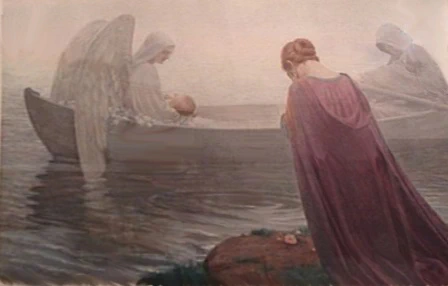The loss of a child

Artwork: Leighton, Edmund Blair. “To the Unknown Land.” 1911.
About
This page contains resources for Catholics facing the loss of a child. The page is in three parts:
1. Care for the remains of the child
2. Rite of Burial for Children
3. Votive Mass of the Holy Angels
Catholic Miscarriage Support1 has many resources on these and similar topics as well.
Care for the remains
In case of necessity, any person can baptize provided that he have the intention of doing that which the Church does and provided that he pours water on the candidate’s head while saying: “I baptize you in the name of the Father, and of the Son, and of the Holy Spirit."2
In danger of death non-solemn baptism can be administered by anyone as long as he uses the proper form and matter and has the right intention. If possible two witnesses or at least one should be present so that the baptism can be proved…It should be a pastor’s concern that the faithful, particularly midwives, doctors, and surgeons be thoroughly instructed in the correct manner of baptizing in a case of necessity.3
Many medical facilities are required to inform parents of their rights regarding the remains of their children.
The exact laws may vary by state; Minnesota law, for example, says:
Hospitals, clinics, and medical facilities must have in place by January 15, 2009, policy for informing a woman of available options for fetal disposition when the woman experiences a miscarriage or is expected to experience a miscarriage.4
The government website for Alberta, Canada, provides options and contact information for families, as well as the steps involved in examinations of fetal remains.4
Connect with the patient advocate to discuss your options.
There are also abundant resources for those who experience a loss, such as an early miscarriage, at home. The Archdiocese of Dubuque offers a several-page handout on infant loss, with advice for care of remains at the hospital or at home.5
Websites like Allay Resources collate resources from around the world on support and information for families. They have extensive resources listed for pregnancy and child loss.6
Rite of Burial for Children
The Rite of Burial for Children seems, at first glance, counterintuitive. No Requiem Mass is said, the vestments are white, not black, and no prayers are said for the soul of the child. Because it is assumed that the child did not commit any actual sin, in the eyes of Heaven this occasion is one of “praise and thanksgiving”:
The rite given here for the burial of a child is not to be regarded as a prayer of petition of the Church for the soul of the child. Rather, it is to be seen as a prayer of praise and thanksgiving to God for having taken the child to the glory and happiness of everlasting life.2
Baptised children under the ‘age of reason’ (seven years) are assumed not to have committed actual (personal) sin; it is therefore not necessary to pray for their release from Purgatory. The Requiem Mass is not said for them; instead, either the Mass of the day, or a votive Mass (usually, the Mass of the Angels), is said for a suitable intention, such as to beg consolation for the family. There are different psalms, prayers, and ceremonies for the reception of the body, the blessing of the coffin at the end of Mass, and the burial, and the celebrant wears a white stole for these parts of the service.7
The Rite of Burial for Children is available
as a PDF here and at Latin Mass Funeral
3. Votive Mass of the Holy Angels
It has been a common practice to say the votive Mass of the Holy Angels for the loss of a child. The Mass is available in a variety of places online.
My own version as a PDF is here.
- On this website
- At Latin Mass Funeral
- At Usus Antiquior8
More reading
St. Gregory of Nyssa. On Infants’ Early Deaths. https://www.newadvent.org/fathers/2912.htm
Thurston, Herbert. “Christian Burial.” In Catholic Encyclopedia. New York: Robert Appleton Company, 1908. https://www.newadvent.org/cathen/03071a.htm
Kwasniewski, Peter. “A Child Singing with the Angels: The Non-Funerary Funeral.” New Liturgical Movement (December 3 2018). http://www.newliturgicalmovement.org/2018/12/a-child-singing-with-angels.html#.X08ArshKjcd
Sources
“Catholic Miscarriage Support.” https://www.catholicmiscarriagesupport.com/ ↩︎
Catholic Church. Catechism of the Catholic Church. https://www.vatican.va/archive/ENG0015/_INDEX.HTM ↩︎ ↩︎
Weller, Philip T. Roman Ritual. The Bruce Publishing Company, 1964. https://sensusfidelium.us/wp-content/uploads/2018/06/Roman-Rite.pdf ↩︎
Policy for Notification of Disposition Options, 145.1622 MN Stat. (2019). https://www.revisor.mn.gov/statutes/2019/cite/145.1622 ↩︎ ↩︎
“Caring for Your Baby’s Remains.” Government of Alberta, Canada, https://myhealth.alberta.ca/after-your-miscarriage/caring-for-your-baby%E2%80%99s-remains ↩︎
“Care of Fetal Remains.” Archdiocese of Dubuque, 2019, https://files.ecatholic.com/23075/documents/2019/11/Care%20of%20Fetal%20Remains.pdf?t=1574875059000 ↩︎
“A Guide to Ensuring You Have the Traditional Mass at Your Funeral " The Latin Mass Society, 2014, https://lms.org.uk/sites/default/files/resource_documents/funeral-guide-jan-2014.pdf ↩︎
“Certain Votive Masses.” Usus Antiquior, https://propria.org/votive-masses/ ↩︎